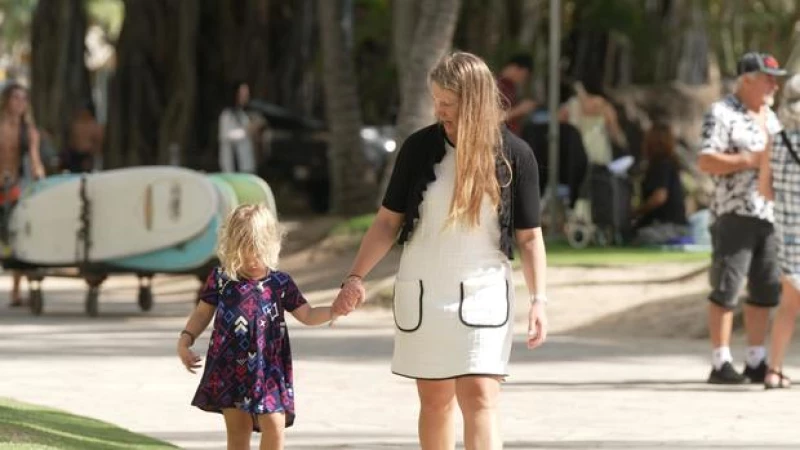A tragic incident unfolded at Red Hill, where a 4-year-old girl and thousands of others were exposed to contaminated water due to jet fuel seeping into the water supply of the Joint Base Pearl Harbor Hickam Navy facility in Hawaii in 2021.
The little girl started experiencing a persistent cough 13 days after the water became tainted, as shared by her mother, Brittany Traeger. Currently, she undergoes hour-long nebulizer treatments to manage her respiratory issues, and wears a vibrating vest twice a day to clear her lungs. Traeger and her husband are part of a group of 2,000 military families taking legal action against the government, holding them responsible for the harm caused by negligence at Red Hill, a fuel storage site near the Pearl Harbor military base.
"There's a clear failure within the government," Traeger expressed. "They contaminated our water, deceived us, failed to ensure our safety, and neglected to take necessary actions."
Unveiling the History of Red Hill
Even before the infamous attack on Pearl Harbor by the Japanese on December 7, 1941, efforts were in place to safeguard the Navy's fuel reserves from potential aerial assaults at Red Hill. The construction, overseen by Vice Admiral John Wade, spanned slightly under three years, involving a workforce of up to 4,000 individuals at its peak.
Deep within the volcanic rock, seven miles of tunnels wind their way through the Red Hill fuel storage facility. Once shrouded in secrecy, this site has supplied fuel for the Pacific Fleet and its aircraft for over 80 years. During a visit with 60 Minutes correspondent Sharyn Alfonsi, Wade unveiled one of the facility's 20 tanks, capable of holding a staggering 12.5 million gallons.
"And to give you kind of a reference point, the Statue of Liberty — not the base, but the statue itself — can fit in here with enough room," Wade remarked.
However, this symbol of American strength and preparedness turned into a significant risk decades later. A crack in a pipe at Red Hill on November 20, 2021, led to the release of 20,000 gallons of jet fuel. Trapped in a plastic conduit, the weight of the fuel caused the pipe to droop, leading to a collision with a trolley.
For 21 harrowing hours, jet fuel gushed dangerously close to a well that provided drinking water for 93,000 individuals in and around the Pearl Harbor base.
Regrettably, the workers who rushed to contain the spill lacked the necessary tools, as later revealed by Navy investigators. Moreover, they mistakenly believed that the drinking water was not at risk.
Tragically, their assumptions were proven wrong. Over 5,000 gallons of jet fuel seeped into the tunnel floor and infiltrated the Navy's water supply.
Reassurances to Affected Families
In the aftermath of the spill, the Navy swiftly issued a press release to address the incident. Assuring the 8,400 families residing in military housing, they stated that "the water remains safe to drink," despite not having conducted water tests at that point.
Water Contamination Incident at Red Hill
Located about two and a half miles from Red Hill, Traeger and her family lived on base. Her husband, a Navy chief petty officer, first noticed something was wrong when he commented on the water smelling like oil after washing his hands in the kitchen.
Shortly after the spill, Traeger began experiencing health issues such as a persistent cough, swollen tonsils, and vertigo. Concerned about the safety of the water, she decided to stop using it for herself and her daughter, despite the base's initial reassurances.

Even though the commanding officer claimed that there were no immediate signs of water contamination, Traeger's instincts led her to avoid using the water and taking precautions. The Navy had provided an email address for residents to request water testing, but Traeger had already taken matters into her own hands.
Navy's U-turn on Water Contamination Issue
After a series of conflicting statements over 12 days, the Navy has made a surprising reversal. On December 2, 2021, it admitted that more thorough tests conducted internally had uncovered traces of jet fuel in the water.
Following the spill, tests conducted by the Hawaii Department of Health three weeks later revealed alarming levels of jet fuel, measuring 350 times higher than the state's safety threshold.
Upon hearing the news, Richelle Dietz, a resident on the base with her Navy chief petty officer husband and two children, was overwhelmed with sickness, leading her to vomit.
"The thought that my children had been exposed to poison is devastating," Dietz expressed.

Within a month post-spill, the Navy arranged medical tents for affected residents who reported symptoms like stomach issues, extreme fatigue, and persistent coughing. Consequently, over 4,000 families were relocated to hotels for safety measures.
To address the contamination, the water system underwent a thorough flush over a span of three months, and bottled water was supplied. It took three months before the drinking water in Pearl Harbor was declared safe for consumption once again.
The Navy's internal investigation into the incident highlighted a series of failures, citing inadequate training, poor supervision, and ineffective leadership at the Red Hill facility, all of which fell below the Navy's expected standards.
Closing Red Hill down
Concerns raised by Hawaiians have been ongoing for the past decade regarding the threat of smaller leaks at Red Hill. The Navy complex sits above the primary water supply for the city of Honolulu, located 100 feet below the surface.
The Secretary of Defense issued an order in March 2022 for the permanent closure of Red Hill. Vice Admiral Wade was tasked with the responsibility of removing 104 million gallons of fuel from the tanks and safely relocating it to sites across the Pacific.
"Our immediate priority is to defuel the tanks. This is the imminent threat," Wade emphasized. "Following this, there will be extensive environmental remediation efforts to restore the aquifer, the land, and the surrounding area. Additionally, there will be a medical component to address those who have been affected."
Within six months, Wade's team in Hawaii successfully extracted almost all of the fuel. However, it took an additional two years before the Navy took disciplinary action, issuing disciplinary letters to 14 officers involved in the spill response, including five admirals.
Assistant Secretary of the Navy, Meredith Berger, stated that the Navy takes accountability seriously.
"Our focus is on accountability within the established system," Berger affirmed. "While we acknowledge that the process took longer than expected and may not have been extensive enough, we are committed to rectifying the situation."
Grappling with health concerns and suing the government
Two thousand military families have joined forces in a lawsuit against the government, alleging that the Navy's actions were inadequate. The trial for this lawsuit is scheduled to commence on Monday.
Dietz, who's joined the suit, feels angry and betrayed. Her husband has been in the Navy for almost 18 years and the family has moved across the country and across oceans for his work.
"We gave so much of our life to the Navy for them to ignore warnings," Dietz said. "And then we were directly and blatantly lied to about it.
Her daughter's tonsils became inflamed days after the spill and her son started suffering from chronic headaches, she said. The mom says neither of them had those problems before November 2021.
Small studies of military personnel suggest jet fuel exposure can lead to neurological and breathing problems, but the long-term impact of ingesting jet fuel is unknown because it's so unlikely to ever happen.
It's unclear how many got sick, but of 2,000 people who responded to a survey by the Centers for Disease Control and Prevention, more than 850 sought medical care.
Navy leadership has apologized for the spill, but has not said that the contaminated water is the cause of the ongoing illnesses. It did set up a clinic on base to collect data and treat anyone who believes they have health issues related to the tainted water.
Berger was asked if those services would still be available down the road.

"We are committed to gathering the necessary information to guide our future actions and determine the needs and care required," Berger explained.
"I want to tread carefully as my expertise lies outside the realm of healthcare," Berger added. "I prefer not to comment beyond my area of authority or decision-making."
Following up with the Defense Department, 60 Minutes reported that they are currently assessing the issue of long-term healthcare for military families, specifically focusing on over 3,100 children.
The Navy has initiated daily testing at Pearl Harbor and has assured the public that the tap water is free from any fuel contamination.
Traeger emphasized the importance of accountability in her statement.
"For me, my family, and all those impacted, I seek a comprehensive care plan that will help restore my faith in our nation," she expressed.







